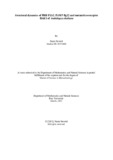Structural dynamics of PRR FLS2, PAMP flg22 and mutated co-receptor BAK1 of Arabidopsis thaliana
Abstract
Pattern-triggered immunity (PTI) acts as the first layer of defense that is deployed by plants in
order to avert microbial invasions. It is actually identified by the activities of patternrecognition
receptors (PRRs), that bind with the pathogen-associated molecular patterns
(PAMPs) and recruit co-receptor protein(s) to convey a defense signal, thereby initiating the
plant’s immunity. In this study, the 122nd amino acid in BAK1 from the crystallographic
structure of FLS2-BAK1-flg22 complex (PDB ID: 4MN8) was mutated from aspartate to
asparagine using in-silico method. Molecular dynamics simulations (100 ns) and MM/PBSA
calculations were then applied for a thorough and comprehensive analysis of the interactions
between PRR FLS2, mutated co-receptor mBAK1 and PAMP flg22. ARG-72 and LYS-36
from FLS2-mBAK1 (in the presence and absence of flg22 respectively), ARG-72 and GLU-
28 from mBAK1-flg22 (in the presence and absence of FLS2 respectively) & LYS-77 and
ASP-176 from FLS2-flg22 (in the presence and absence of mBAK1 respectively) were
revealed to be the most prominent residues, aiding notably in the process of heterodimerization
during PTI, subsequently mediated by FLS2. A hypothesis can thereby be established, that
mutation at any of these residues will affect the PTI of Arabidopsis thaliana. The simulations
were also compared using parameters such as root mean square deviation (RMSD), root mean
square fluctuation (RMSF), the radius of gyration (Rg), solvent accessible surface areas
(SASA) and the number of hydrogen bonds (H-bond) to comprehend the structural integrity of
the complex. The obtained results demonstrated that PAMP flg22 interacted much more
favorably with the PRR FLS2 in the presence of mutated co-receptor mBAK1 in the complex,
which implicates the necessity of the co-receptor in FLS2 mediated PTI to recognize PAMP
flg22. Furthermore, since FLS2 has been shown to play a key role in Arabidopsis thaliana plant
defense mechanism, its assumed binding mechanism with PAMP and co-receptor BAK1 will
help paint an improved comprehension of the inceptive stages of PTI.

